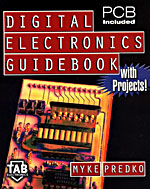Review: Digital Electronics Guidebook
 Amazon.com: Digital Electronics Guidebook: With Projects!: Books: Michael Predko
Amazon.com: Digital Electronics Guidebook: With Projects!: Books: Michael PredkoWhile this book is not very well known and doesn't sound particularly intellectual, I've found it to be a hidden gem - albeit with many sharp corners to cut yourself on if you're not paying attention. The sharp corners have proved to be both a curse and a blessing in disguise, as I frequently found myself scratching my head as to what was really meant by something that was clearly an error, and as such had to work through the logic myself to see what was going on and what the correct information was. This was unfortunately so frequent that I soon found myself double checking everything in the book as I had little faith in the correctness of even simple things.
Of these simple errors, the single most disgusting and frequent on is his use of 0.1uF tantalum capacitors for decoupling throughout the entire book. When decoupling was initially discussed, he stated that he uses tantalum capacitors because they are better than ceramics for this purpose (due to their lower ESR; effective series resistance) - and this is completely wrong! Looking at any datasheets, or doing research on this topic online or in any other book will show you that you actually should avoid using tantalum capacitors for this task as they are nearly useless. Given frequent the need for decoupling digital circuits, this error can be seen in every single circuit in the book.
Myke Predko gives a very in-depth treatment to the operation of TTL gates with a somewhat less in-depth treatment of CMOS gates. This is rather suprising considering that it is stated several times throughout the book that CMOS gates are far more prevelant in modern circuits and microcontrollers. Having said that, CMOS gates are not ignored and there is a decent amount of information about them scattered through the book.
That brings me to the next point; the books layout is quite scattered in several parts. A good example of this is the several parts of the book dedicated to the operation of buses, where initially several pages were dedicated to their introduction only for it to be interrupted by a completely different section without all the questions that were raised having been answered first. Later on they are picked up again and discussed in some more detail - and dropped again, still before all your questions have been answered! The cycle then repeats with more discussions later.
More disturbing than this is the important questions that were raised that simply were swept under the carpet without any attempt at even giving you a direction to look into yourself. An example of this from on of the first discussions on buses is the termination of long buses to avoid reflections when the signals reach the end of the lines and are not fully attenuated yet. The issue is brought up and a clear description of the problem is given.. but nothing on what to do to solve it! In a much later discussion on other aspects of buses (specifically communication), it is briefly mentioned that you can put a resistor of "a few hundred k" at the end of the bus line and ground to reduce the issue. That's nice. Does it apply to all bus designs? Only this one? Should it always be "a few hundred k"? From the initial discussion of this subject, this is a very important issue and can easily be fatal to a circuits design, so where's the solution?
As I stated at the very beginning of this review, I found this book to be a hidden gem. Given everything negative that I've said about the book so far, how can this be? Well, despite the abundant typos, errors, and mislabeled diagrams, the writing is very, very easy to understand and goes a lot slower and more in-depth than most similar books. Coupled with the need to double check most things for yourself, you get a very good understanding of the operation of the devices and circuits that Myke discusses - and as such, this has been one of the few books that I've read recently that I feel that I've truely asorbed and processed the information in.
Now for the bad news.
You're unlikely to find this book any longer as it is now out of print (it was in print for less than 4 years it seems from the publication date given on Amazon). There are some alternate sellers, who still have the book available, listed on the Amazon page for this book, so hope is not lost.
Overall I'd give the book 4/5 stars, which is a testament to how good the book is to recover from its many serious flaws.


0 Comments:
Post a Comment
<< Home